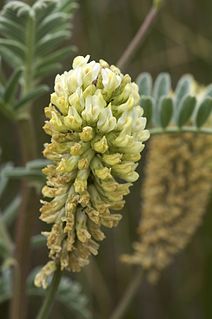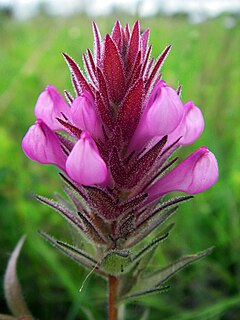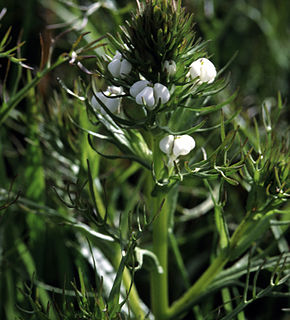
California coastal prairie, also known as northern coastal grassland, is a grassland plant community of California and Oregon in the temperate grasslands, savannas, and shrublands biome. It is found along the Pacific Coast, from as far south as Los Angeles in Southern California up into southern Oregon.

Triphysaria is a genus of five plants in the family Orobanchaceae which are known generally as owl's-clovers. This genus is closely related to the genera Castilleja and Orthocarpus. Triphysaria are native to western North America, including a species endemic to California.

Astragalus pycnostachyus is a species of milkvetch known by the common name marsh milkvetch. It is endemic to the coastline of California, where it grows in wet saline habitat such as marshes.
Cordylanthus orcuttianus is a rare species of flowering plant in the family Orobanchaceae known by the common name Orcutt's bird's beak. It is native to Baja California and southern San Diego County, California, where few populations are known. It is a plant of coastal scrub habitat. This annual herb grows to a maximum of half a meter in height and is green to reddish-green in color and coated in stiff hairs. The leaves are up to 8 centimeters long and dissected into narrow segments. The inflorescence is a very dense cluster of flowers surrounded by bracts which are divided into narrow segments like the leaves. Each flower is up to 2.5 centimeters long and is made up of a yellow-tipped white fibrous pouch enclosed by a calyx of sepals.
Eriastrum virgatum is a species of flowering plant in the phlox family known by the common name wand woollystar. It is endemic to California, where it is known the coastline and coastal mountain ranges of Monterey and San Benito Counties. It grows in chaparral and coastal and inland scrub habitat. It is an annual herb producing a thin, usually woolly stem up to about 40 centimeters tall. The leaves are narrow and thick, up to 5 centimeters long, and sometimes divided into two narrow lobes. The inflorescence is a woolly cluster of narrow, leaflike bracts laced with webby fibers. The flowers have yellow throats and bright blue corollas with lobes up to a centimeter long.

Mitella ovalis is a species of flowering plant in the saxifrage family known by the common names coastal miterwort and oval-leaf miterwort. It is native to western North America from southwestern British Columbia, including Vancouver Island, to northern California as far south as Marin County. It grows in moist, shady habitat, such as coastal forests and streambanks. It is a rhizomatous perennial herb growing up to about 35 or 40 centimeters tall. The leaves occur around the base of the stem. They have oval blades up to 5 centimeters wide with toothed, lobed edges. The erect inflorescence bears several flowers, generally 20 to 60, usually along one side of the stem. The distinctive flower is saucer-shaped with five greenish yellow petals which are divided into narrow, whiskerlike lobes.

Orthocarpus bracteosus is a species of flowering plant in the broomrape family known by the common name rosy owl's-clover. It is native to western North America from British Columbia to northern California, where it grows in moist mountain habitat, such as meadows.

Orthocarpus cuspidatus is a species of flowering plant in the broomrape family known by the common names Copeland's owl's clover, Siskiyou Mountains orthocarpus, and toothed owl's-clover. It is native to mountain and plateau habitat in Oregon, California, and Nevada. It is an annual herb producing a slender, glandular, hairy, purple-green stem up to about 40 centimeters tall. The narrow leaves are up to 5 centimeters long, the upper ones deeply divided into three linear lobes. The inflorescence is a dense cylindrical spike of wide, oval green bracts with pinkish points. The flowers emerge from between the bracts. Each purple-pink flower is fuzzy in texture and club-shaped, the lower lip an expanded pouch and the upper lip a narrow, straight beak.

Orthocarpus imbricatus is a species of flowering plant in the broomrape family known by the common name mountain owl's-clover. It is native to western North America from British Columbia to northern California, where it grows in meadows and other mountain habitat.

Orthocarpus luteus is a species of flowering plant in the broomrape family known by the common name yellow owl's-clover. It is native to much of western and central North America, where it grows in many types of plateau, grassland, and mountain habitat.
Orthocarpus pachystachyus is a rare species of flowering plant in the broomrape family known by the common names Shasta owl's-clover and Shasta orthocarpus. It is endemic to central Siskiyou County, California, where it is so rarely seen it was thought to be extinct until 1996, when eight individuals were located. The plant grows in an isolated wilderness but since it apparently only occurs on one single hillside it is considered very vulnerable to extinction.

Phacelia floribunda is a species of phacelia known by the common names many-flowered phacelia, southern island phacelia and San Clemente Island phacelia. It is known only from San Clemente Island, one of the Channel Islands of California, and Guadalupe Island off the coast of Baja California. It grows in coastal sage scrub habitat in the canyons of these two islands.
Polygonum marinense is a rare North American species of flowering plants in the buckwheat family known by the common name Marin knotweed. It is endemic to California, where it is known from just a few locations north and east of San Francisco Bay.
Streptanthus breweri is a species of flowering plant in the mustard family known by the common name Brewer's jewelflower. It is endemic to California, where it can be found in the coastal mountain ranges from the Klamath Mountains south to the San Francisco Bay Area. Its habitat includes chaparral and woodlands, usually on serpentine soils. It is an annual herb producing an erect, branching stem up to about 80 centimeters in maximum height. It is hairless except for fine hairs on some of the inflorescence parts, and it may be waxy in texture. The basal leaves have oval blades borne on petioles, and the lance-shaped leaves farther up the stem clasp it at their bases. Flowers occur at intervals along the upper stem, sometimes in a zig-zagging, one-sided array. Each has an urn-shaped calyx of keeled greenish or purplish sepals under a centimeter long. White, purple, or purple-veined white petals emerge from the tip. The fruit is a narrow, curved silique which may be 9 to 11 centimeters in length.
Trifolium barbigerum is a species of clover known by the common name bearded clover.
Trifolium buckwestiorum is a rare species of clover known by the common name Santa Cruz clover.

Triphysaria eriantha is a species of flowering plant in the family Orobanchaceae, known by the common names johnny-tuck and butter-and-eggs.
Triphysaria micrantha is a species of flowering plant in the family Orobanchaceae known by the common name purplebeak owl's-clover. It is endemic to California, where it is known from the grasslands of the Central Valley and the foothills to the east and west. It an annual herb producing a hairy, glandular, purple-colored stem up to about 15 centimeters in maximum height. Like many species in its family it is a facultative root parasite on other plants, attaching to their roots via haustoria to tap nutrients. Its greenish to red-purple leaves are up to 2.5 centimeters long and are sometimes divided into a few narrow, pointed lobes. The inflorescence is a spike of flowers a few centimeters in length. Each flower has a narrow purple upper lip and a wide lower lip which is divided into yellowish or white pouches, often with purple markings on the lower parts.

Triphysaria pusilla is a species of flowering plant in the family Orobanchaceae known by the common name dwarf owl's-clover.

Triphysaria versicolor is a species of flowering plant in the family Orobanchaceae known by the common name yellowbeak owl's-clover.













